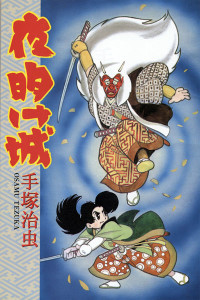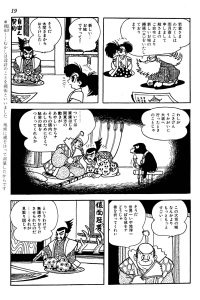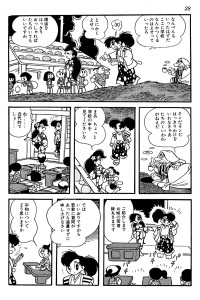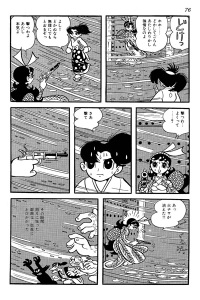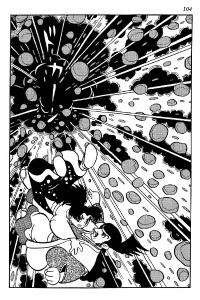Castle of Dawn (Manga)
Also known as 夜明け城 (Yoake Shiro)
| English Title: | Castle of Dawn |
| In English? | Yes (digital) |
| Japanese Title: | 夜明け城 Yoake Shiro |
| Type: | Ongoing Serial |
| Original run: | 1959/09 – 1961/03 |
| Published in: | Seventh Grader 中学一年コース Eighth Grader 中学二年コース |
| Published by: | Gakushu Kenkyusha |
| Volumes: | 1 MT-050 |
Originally published from September 1959 to March 1961 in Seventh Grader and Eighth Grader, Osamu Tezuka’s Castle of Dawn (1959-61) is one of several samurai-style series, including The Shinsengumi (1963) and I Am Sarutobi! (1960-61), which are set against the backdrop of important moments in Japan’s history.
What it’s about
In 1594, during the Momoyama Period, Japan was ruled by Lord Hideyoshi Toyotomi. However, in an effort to blunt the movements of his main rival, Lord Ieyasu Tokugawa, in the Kanto region (now home to modern-day Tokyo) to the north, Lord Toyotomi instructs his vassal, Lord Muneharu Matsunoki to construct a new castle on his lands. This is not to be just any castle though… but one built in a traditional European style – a plan so secret, that even a suspected glimpse of the blueprints could mean the death penalty. Lord Matsunoki whole-heartedly embraces the task ahead of him, and decides to bring his son, the young Lord Midorimaru Matsunoki, on board to help him.
A brash and fearless youth, at first Midorimaru is excited by the project. However he quickly realizes that the site selected for the new castle is already occupied, and that its construction will mean the destruction and relocation of a peasant village – including a school for young children. Although Midorimaru encourages the school’s young and beautiful teacher, O-Tae to leave, given the secrecy of the project, he is unable to provide her with a compelling reason to do so. Eventually O-Tae’s stubborn refusal lands her in prison.
Haunted by thoughts of O-Tae’s anti-war stance, Midorimaru begins visiting her in the dungeon and eventually comes to see the error of his ways – and specifically his father’s plans. When news of these visits reach the Lady Yayoi, the most beautiful girl in the castle and all-but-betrothed to Midorimaru, it throws her into a jealous rage and she is soon plotting to have O-Tae put to death for her “crimes”. When Midorimaru catches wind of the plot, he saves O-Tae and renounces his noble status, preferring to live a simple peasant life with her rather than be associated with the new castle project.
Meanwhile, as construction begins on what will become known as the “Castle of Dawn”, the project is almost halted before it begins as a series of fatal accidents ybegin to look more and more like acts of sabotage. Despite potentially having a traitor in his midst and a mounting casualty count, including Minister Yabuhebi, the Chief Retainer and Yayoi’s father, for Lord Matsunoki, completing the castle, at any or all cost, has become a single-minded obsession.
Of course, her father’s death and suspected murder puts Yayoi down a path looking for revenge, and Midorimaru, despite living the quiet life of a peasant, is drawn into the search for the traitor and saboteur. However, when Lord Hideyoshi dies, and Tokugawa troops take the field, the future of Lord Matsunoki’s life’s work – one which he has sacrificed everything for – becomes less and less certain…
What you should know
Like many of Tezuka’s manga, Castle of Dawn (1959-61) features a very strong anti-war message. However, instead of merely preaching to his readership, Tezuka cleverly crafts his message to be delivered “from the mouths of babes” by having his dashing young hero, Midorimaru, have to defend his violent samurai lifestyle against an onslaught of wholly-reasonable questions posed by schoolchildren. Why, for example, couldn’t Lord Toyotomi and Lord Ieyasu Tokugawa just hold a joint summit and sit down and talk out their differences? Furthermore, by following this up with his hero effectively renouncing his life of violence by opposing his father’s plans, Tezuka makes his point quite clearly.
However, despite making his point, Tezuka is also well-known for pushing his readers, even the young ones, to question the motivations and ethics of his characters, and letting them form their own thoughts and opinions. Castle of Dawn (1959-61) is no exception. By introducing a charismatic traitor into the mix, Tezuka is able to show that sometimes good men do bad things, for good reasons… Often to tragic outcomes. He also shows that there are consequences to folly, and not all stories have happy endings.
Finally, Tezuka never lets an opportunity slip by for an inside joke or two. One prime example of this is the depiction of the monkey eating ice cream in Lord Hideyoshi Toyotomi’s chambers… A fun little poke at Hideyoshi’s nickname of Saru (Monkey) due to his less-than-handsome features. Another is the name of the Tokugawa general that comes to lay siege to the Castle of Dawn, Mitsutoshi Furuya… a mangaka who was one of Tezauka’s assistants at the time.
Where you can get it
In 2015 as part of DMP’s Digital Manga Guild initiative, Castle of Dawn (1959-61) was published in English as a digital-only release. It is available for legal download on the emanga.com website in a variety of popular reading formats (ePub, CBR/CBZ, PDF, etc.).

